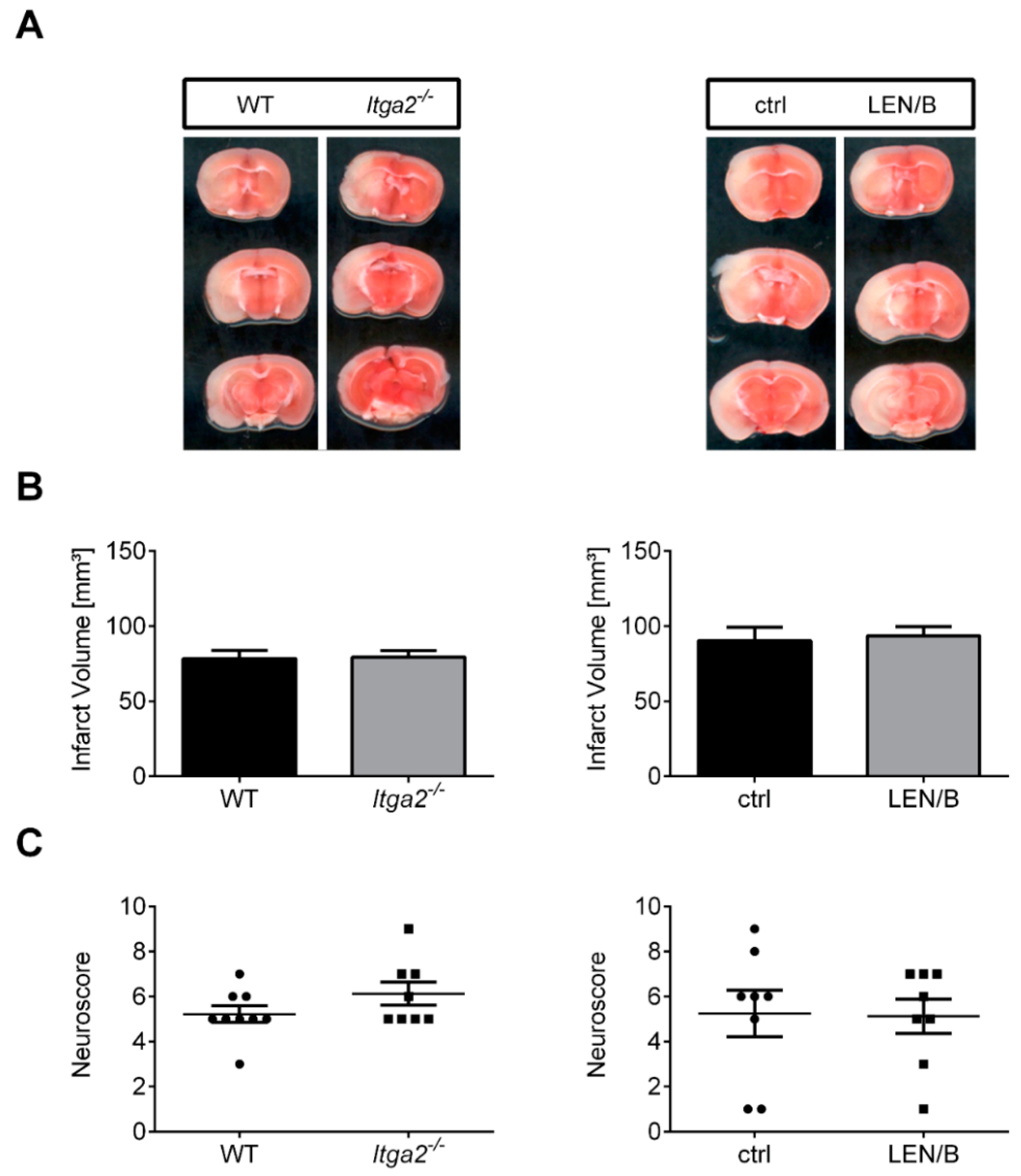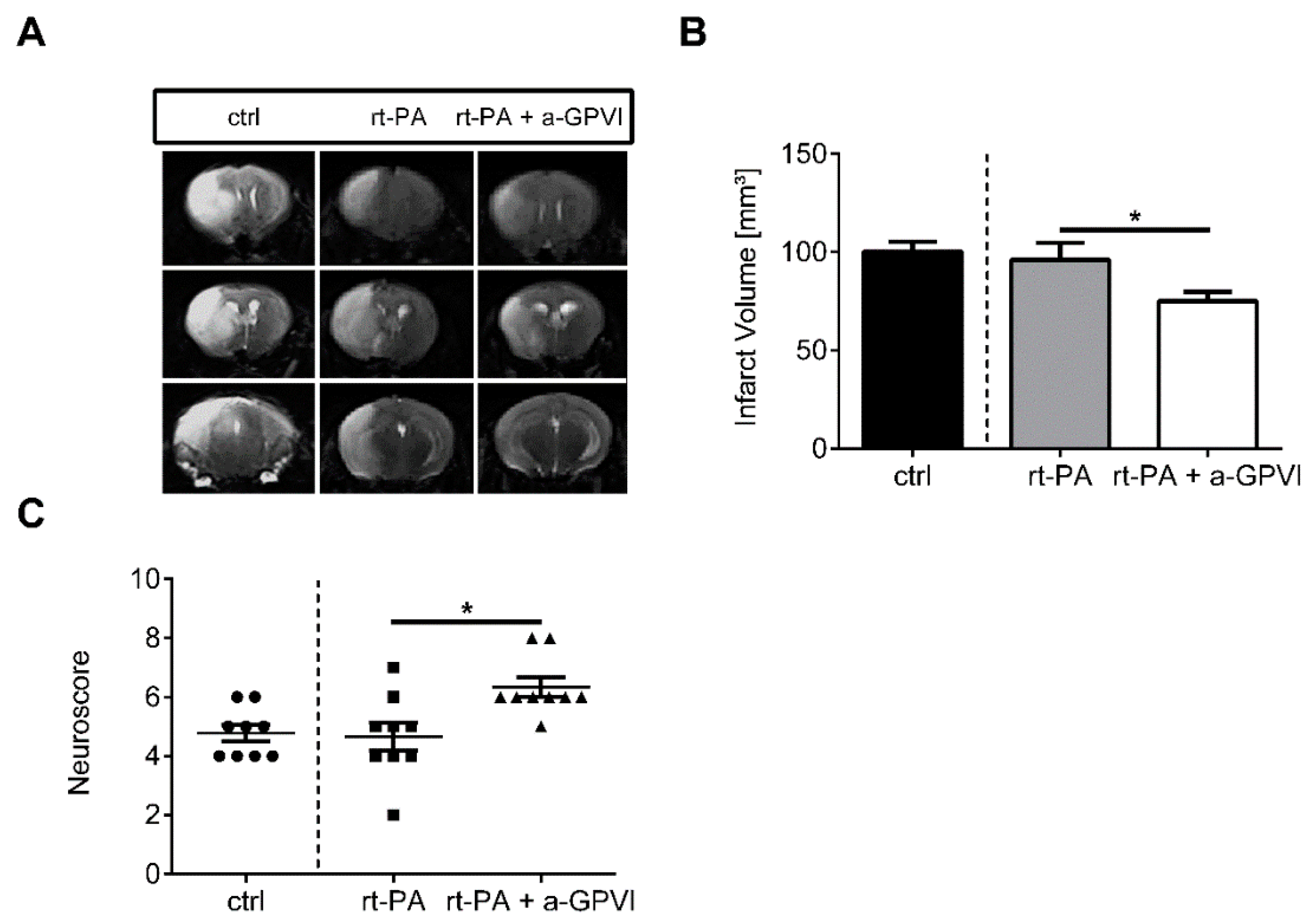Targeting Platelet GPVI Plus rt-PA Administration but Not α2β1-Mediated Collagen Binding Protects against Ischemic Brain Damage in Mice
Abstract
1. Introduction
2. Results
2.1. Targeting α2β1-Integrin Does Not Improve Outcome after tMCAO
2.2. Blocking the Collagen Receptor GPVI Together with IV rt-PA Treatment after tMCAO Is Safe and Effective
3. Discussion
4. Materials and Methods
4.1. Animals and Ethics
4.2. Animal Treatment
4.3. Sample Size Calculation
4.4. tMCAO
4.5. Exclusion Criteria
4.6. Magnetic Resonance Imaging
4.7. Evaluation of Bleeding Severity (SWI Score)
4.8. Statistical Analysis
Author Contributions
Funding
Acknowledgments
Conflicts of Interest
References
- Berkhemer, O.A.; Fransen, P.S.; Beumer, D.; van den Berg, L.A.; Lingsma, H.F.; Yoo, A.J.; Schonewille, W.J.; Vos, J.A.; Nederkoorn, P.J.; Wermer, M.J.; et al. A randomized trial of intraarterial treatment for acute ischemic stroke. N. Engl. J. Med. 2015, 372, 11–20. [Google Scholar] [CrossRef]
- Global Burden of Disease Study Collaborators. Global, regional, and national incidence, prevalence, and years lived with disability for 301 acute and chronic diseases and injuries in 188 countries, 1990–2013: A systematic analysis for the Global Burden of Disease Study 2013. Lancet 2015, 386, 743–800. [Google Scholar] [CrossRef]
- Hallenbeck, J.M.; Dutka, A.J. Background review and current concepts of reperfusion injury. Arch. Neurol. 1990, 47, 1245–1254. [Google Scholar] [CrossRef]
- Zinkstok, S.M.; Beenen, L.F.; Majoie, C.B.; Marquering, H.A.; de Haan, R.J.; Roos, Y.B. Early deterioration after thrombolysis plus aspirin in acute stroke: A post hoc analysis of the antiplatelet therapy in combination with recombinant t-pa thrombolysis in ischemic stroke trial. Stroke 2014, 45, 3080–3082. [Google Scholar] [CrossRef] [PubMed]
- Savage, B.; Almus-Jacobs, F.; Ruggeri, Z.M. Specific synergy of multiple substrate-receptor interactions in platelet thrombus formation under flow. Cell 1998, 94, 657–666. [Google Scholar] [CrossRef]
- Nieswandt, B.; Brakebusch, C.; Bergmeier, W.; Schulte, V.; Bouvard, D.; Mokhtari-Nejad, R.; Lindhout, T.; Heemskerk, J.W.; Zirngibl, H.; Fassler, R. Glycoprotein vi but not α2β1 integrin is essential for platelet interaction with collagen. EMBO J. 2001, 20, 2120–2130. [Google Scholar] [CrossRef] [PubMed]
- Stegner, D.; Haining, E.J.; Nieswandt, B. Targeting glycoprotein vi and the immunoreceptor tyrosine-based activation motif signaling pathway. Arterioscler. Thromb. Vasc. Biol. 2014, 34, 1615–1620. [Google Scholar] [CrossRef]
- Gawaz, M. Novel ligands for platelet glycoprotein vi. Thrombo. Haemost. 2018, 118, 435–436. [Google Scholar] [CrossRef] [PubMed]
- Jung, S.M.; Moroi, M. Platelets interact with soluble and insoluble collagens through characteristically different reactions. J. Biol. Chem. 1998, 273, 14827–14837. [Google Scholar] [CrossRef] [PubMed]
- Gruner, S.; Prostredna, M.; Schulte, V.; Krieg, T.; Eckes, B.; Brakebusch, C.; Nieswandt, B. Multiple integrin-ligand interactions synergize in shear-resistant platelet adhesion at sites of arterial injury in vivo. Blood 2003, 102, 4021–4027. [Google Scholar] [CrossRef]
- Holtkotter, O.; Nieswandt, B.; Smyth, N.; Muller, W.; Hafner, M.; Schulte, V.; Krieg, T.; Eckes, B. Integrin α 2-deficient mice develop normally, are fertile, but display partially defective platelet interaction with collagen. J. Biol. Chem. 2002, 277, 10789–10794. [Google Scholar] [CrossRef]
- Shida, Y.; Rydz, N.; Stegner, D.; Brown, C.; Mewburn, J.; Sponagle, K.; Danisment, O.; Crawford, B.; Vidal, B.; Hegadorn, C.A.; et al. Analysis of the role of von willebrand factor, platelet glycoprotein vi-, and α2β1-mediated collagen binding in thrombus formation. Blood 2014, 124, 1799–1807. [Google Scholar] [CrossRef]
- Goebel, S.; Li, Z.; Vogelmann, J.; Holthoff, H.P.; Degen, H.; Hermann, D.M.; Gawaz, M.; Ungerer, M.; Munch, G. The gpvi-fc fusion protein revacept improves cerebral infarct volume and functional outcome in stroke. PLoS ONE 2013, 8, e66960. [Google Scholar] [CrossRef]
- Kleinschnitz, C.; Pozgajova, M.; Pham, M.; Bendszus, M.; Nieswandt, B.; Stoll, G. Targeting platelets in acute experimental stroke: Impact of glycoprotein ib, vi, and iib/iiia blockade on infarct size, functional outcome, and intracranial bleeding. Circulation 2007, 115, 2323–2330. [Google Scholar] [CrossRef]
- Kraft, P.; Schuhmann, M.K.; Fluri, F.; Lorenz, K.; Zernecke, A.; Stoll, G.; Nieswandt, B.; Kleinschnitz, C. Efficacy and safety of platelet glycoprotein receptor blockade in aged and comorbid mice with acute experimental stroke. Stroke 2015, 46, 3502–3506. [Google Scholar] [CrossRef] [PubMed]
- Ning, M.; Furie, K.L.; Koroshetz, W.J.; Lee, H.; Barron, M.; Lederer, M.; Wang, X.; Zhu, M.; Sorensen, A.G.; Lo, E.H.; et al. Association between tpa therapy and raised early matrix metalloproteinase-9 in acute stroke. Neurology 2006, 66, 1550–1555. [Google Scholar] [CrossRef]
- Inzitari, D.; Giusti, B.; Nencini, P.; Gori, A.M.; Nesi, M.; Palumbo, V.; Piccardi, B.; Armillis, A.; Pracucci, G.; Bono, G.; et al. MMP9 variation after thrombolysis is associated with hemorrhagic transformation of lesion and death. Stroke 2013, 44, 2901–2903. [Google Scholar] [CrossRef]
- Schuhmann, M.K.; Kraft, P.; Bieber, M.; Haarmann, A.; Homola, G.A.; Pham, M.; Nieswandt, B.; Stoll, G. Influence of thrombolysis on the safety and efficacy of blocking platelet adhesion or secretory activity in acute ischemic stroke in mice. Transl. Stroke Res. 2018, 9, 493–498. [Google Scholar] [CrossRef] [PubMed]
- Cherpokova, D.; Bender, M.; Morowski, M.; Kraft, P.; Schuhmann, M.K.; Akbar, S.M.; Sultan, C.S.; Hughes, C.E.; Kleinschnitz, C.; Stoll, G.; et al. SLAP/SLAP2 prevent excessive platelet (hem) itam signaling in thrombosis and ischemic stroke in mice. Blood 2015, 125, 185–194. [Google Scholar] [CrossRef]
- Mammadova-Bach, E.; Ollivier, V.; Loyau, S.; Schaff, M.; Dumont, B.; Favier, R.; Freyburger, G.; Latger-Cannard, V.; Nieswandt, B.; Gachet, C.; et al. Platelet glycoprotein vi binds to polymerized fibrin and promotes thrombin generation. Blood 2015, 126, 683–691. [Google Scholar] [CrossRef] [PubMed]
- Dittmeier, M.; Wassmuth, K.; Schuhmann, M.K.; Kraft, P.; Kleinschnitz, C.; Fluri, F. Dabigatran etexilate reduces thrombin-induced inflammation and thrombus formation in experimental ischemic stroke. Curr. Neurovasc. Res. 2016, 13, 199–206. [Google Scholar] [CrossRef]
- Adams, H.P.; Effron, M.B.; Torner, J.; Davalos, A.; Frayne, J.; Teal, P.; Leclerc, J.; Oemar, B.; Padgett, L.; Barnathan, E.S.; et al. Emergency administration of abciximab for treatment of patients with acute ischemic stroke: Results of an international phase iii trial—Abciximab in emergency treatment of stroke trial (abestt-ii). Stroke 2008, 39, 87–99. [Google Scholar] [CrossRef]
- Kellert, L.; Hametner, C.; Rohde, S.; Bendszus, M.; Hacke, W.; Ringleb, P.; Stampfl, S. Endovascular stroke therapy tirofiban is associated with risk of fatal intracerebral hemorrhage and poor outcome. Stroke 2013, 44, 1453–1455. [Google Scholar] [CrossRef] [PubMed]
- Nieswandt, B.; Schulte, V.; Bergmeier, W.; Mokhtari-Nejad, R.; Rackebrandt, K.; Cazenave, J.P.; Ohlmann, P.; Gachet, C.; Zirngibl, H. Long-term antithrombotic protection by in vivo depletion of platelet glycoprotein vi in mice. J. Exp. Med. 2001, 193, 459–469. [Google Scholar] [CrossRef]
- Moran, P.M.; Higgins, L.S.; Cordell, B.; Moser, P.C. Age-related learning deficits in transgenic mice expressing the 751-amino acid isoform of human β-amyloid precursor protein. Proc. Natl. Acad. Sci. USA 1995, 92, 5341–5345. [Google Scholar] [CrossRef] [PubMed]
- Bederson, J.B.; Pitts, L.H.; Tsuji, M.; Nishimura, M.C.; Davis, R.L.; Bartkowski, H. Rat middle cerebral artery occlusion: Evaluation of the model and development of a neurologic examination. Stroke 1986, 17, 472–476. [Google Scholar] [CrossRef] [PubMed]


| SWI Score | 0 | 1 | 2 |
|---|---|---|---|
| rt-PA | 6/9 | 2/9 | 1/9 |
| rt-PA + a-GPVI | 7/9 | 2/9 | 0/9 |
© 2019 by the authors. Licensee MDPI, Basel, Switzerland. This article is an open access article distributed under the terms and conditions of the Creative Commons Attribution (CC BY) license (http://creativecommons.org/licenses/by/4.0/).
Share and Cite
Schuhmann, M.K.; Kraft, P.; Bieber, M.; Kollikowski, A.M.; Schulze, H.; Nieswandt, B.; Pham, M.; Stegner, D.; Stoll, G. Targeting Platelet GPVI Plus rt-PA Administration but Not α2β1-Mediated Collagen Binding Protects against Ischemic Brain Damage in Mice. Int. J. Mol. Sci. 2019, 20, 2019. https://doi.org/10.3390/ijms20082019
Schuhmann MK, Kraft P, Bieber M, Kollikowski AM, Schulze H, Nieswandt B, Pham M, Stegner D, Stoll G. Targeting Platelet GPVI Plus rt-PA Administration but Not α2β1-Mediated Collagen Binding Protects against Ischemic Brain Damage in Mice. International Journal of Molecular Sciences. 2019; 20(8):2019. https://doi.org/10.3390/ijms20082019
Chicago/Turabian StyleSchuhmann, Michael K., Peter Kraft, Michael Bieber, Alexander M. Kollikowski, Harald Schulze, Bernhard Nieswandt, Mirko Pham, David Stegner, and Guido Stoll. 2019. "Targeting Platelet GPVI Plus rt-PA Administration but Not α2β1-Mediated Collagen Binding Protects against Ischemic Brain Damage in Mice" International Journal of Molecular Sciences 20, no. 8: 2019. https://doi.org/10.3390/ijms20082019
APA StyleSchuhmann, M. K., Kraft, P., Bieber, M., Kollikowski, A. M., Schulze, H., Nieswandt, B., Pham, M., Stegner, D., & Stoll, G. (2019). Targeting Platelet GPVI Plus rt-PA Administration but Not α2β1-Mediated Collagen Binding Protects against Ischemic Brain Damage in Mice. International Journal of Molecular Sciences, 20(8), 2019. https://doi.org/10.3390/ijms20082019





